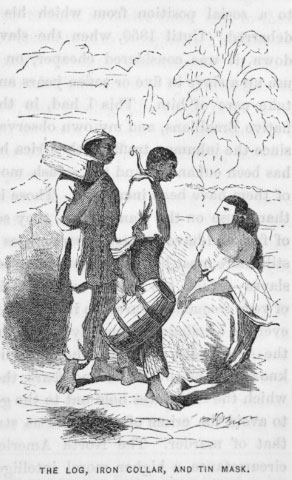Resistance to Slavery

Resistance is the story of slavery itself. From the first moment of attack and capture in their homeland, Africans sought to escape from bondage. On the trek to the Atlantic coast, while bound together by ropes and other equipment, individuals tried to escape their captors. In the trading forts, castles, or barracoons along the African coast, men and women attempted to escape and fight back. Aboard anchored slave ships, before departure to the Americas, they tried to mutiny or flee.
Resistance to slavery continued at every turn in the Americas, as well. Newly arrived Africans and their descendants fled from forced labor, harsh punishment, torture, abuse, and the threat of family separation—sometimes alone, sometimes with others. They sought reunion with loved ones, sanctuary in hills or swamps, or freedom outside the confines of slave society. Often, slave owners knew where enslaved people were heading and advertised accordingly for their return.
Collective resistance could take the form of secret networks to freedom, as with the Underground Railroad in North America or communications networks, as with those of black sailors and seamen working in eighteenth-century Atlantic ports. Established maroon communities in Jamaica, Suriname, and Brazil formed elaborate systems for defense, communications, and subsistence, frequently involving the collusion of those who remained on plantations.
Rebellions plagued slaveholders and colonial governments throughout the era of transatlantic slave trade and slavery, most famously during the Age of Revolutions on the French Caribbean islands of Guadeloupe, Martinique, and Saint-Domingue (now Haiti). In Saint-Domingue, enslaved people allied themselves with various free people of color in the colony to transform their rebellion into a full-scale revolution that brought an end to slavery in French colonies within three years.
The overwhelming majority of enslaved people in the Americas, however, did not revolt. Most learned to resist by accommodating themselves to a lifetime of labor and bondage. They developed their own means of resisting the demands and dangers of slavery—of doing what was required but knowing how to minimize the risks and dangers around them. Enslaved people taught their children important life-lessons, including how to cope with the risks and humiliations of bondage.
History & Memory
Related Pages:
-
 Blue and John Crow Mountains National Park
Blue and John Crow Mountains National Park
-
 Jamaica
Jamaica
-
 Municipalities of Regla-Guanabacoa
Municipalities of Regla-Guanabacoa
-
 1811 Slave Revolt Memorial
1811 Slave Revolt Memorial
-
 Chateau de Joux
Chateau de Joux

